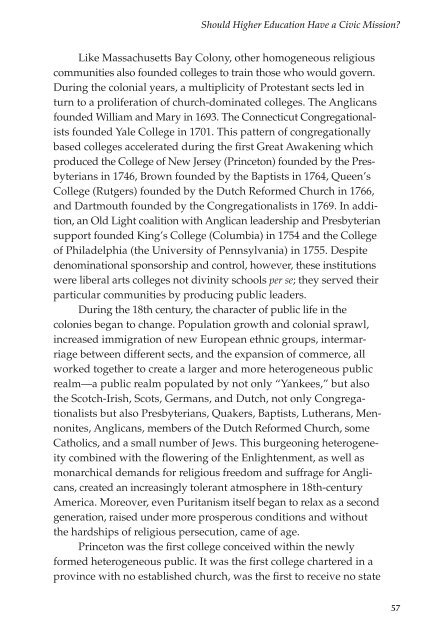Agent of Democracy - Society for College and University Planning
Agent of Democracy - Society for College and University Planning
Agent of Democracy - Society for College and University Planning
You also want an ePaper? Increase the reach of your titles
YUMPU automatically turns print PDFs into web optimized ePapers that Google loves.
Should Higher Education Have a Civic Mission?<br />
Like Massachusetts Bay Colony, other homogeneous religious<br />
communities also founded colleges to train those who would govern.<br />
During the colonial years, a multiplicity <strong>of</strong> Protestant sects led in<br />
turn to a proliferation <strong>of</strong> church-dominated colleges. The Anglicans<br />
founded William <strong>and</strong> Mary in 1693. The Connecticut Congregationalists<br />
founded Yale <strong>College</strong> in 1701. This pattern <strong>of</strong> congregationally<br />
based colleges accelerated during the first Great Awakening which<br />
produced the <strong>College</strong> <strong>of</strong> New Jersey (Princeton) founded by the Presbyterians<br />
in 1746, Brown founded by the Baptists in 1764, Queen’s<br />
<strong>College</strong> (Rutgers) founded by the Dutch Re<strong>for</strong>med Church in 1766,<br />
<strong>and</strong> Dartmouth founded by the Congregationalists in 1769. In addition,<br />
an Old Light coalition with Anglican leadership <strong>and</strong> Presbyterian<br />
support founded King’s <strong>College</strong> (Columbia) in 1754 <strong>and</strong> the <strong>College</strong><br />
<strong>of</strong> Philadelphia (the <strong>University</strong> <strong>of</strong> Pennsylvania) in 1755. Despite<br />
denominational sponsorship <strong>and</strong> control, however, these institutions<br />
were liberal arts colleges not divinity schools per se; they served their<br />
particular communities by producing public leaders.<br />
During the 18th century, the character <strong>of</strong> public life in the<br />
colonies began to change. Population growth <strong>and</strong> colonial sprawl,<br />
increased immigration <strong>of</strong> new European ethnic groups, intermarriage<br />
between different sects, <strong>and</strong> the expansion <strong>of</strong> commerce, all<br />
worked together to create a larger <strong>and</strong> more heterogeneous public<br />
realm—a public realm populated by not only “Yankees,” but also<br />
the Scotch-Irish, Scots, Germans, <strong>and</strong> Dutch, not only Congregationalists<br />
but also Presbyterians, Quakers, Baptists, Lutherans, Mennonites,<br />
Anglicans, members <strong>of</strong> the Dutch Re<strong>for</strong>med Church, some<br />
Catholics, <strong>and</strong> a small number <strong>of</strong> Jews. This burgeoning heterogeneity<br />
combined with the flowering <strong>of</strong> the Enlightenment, as well as<br />
monarchical dem<strong>and</strong>s <strong>for</strong> religious freedom <strong>and</strong> suffrage <strong>for</strong> Anglicans,<br />
created an increasingly tolerant atmosphere in 18th-century<br />
America. Moreover, even Puritanism itself began to relax as a second<br />
generation, raised under more prosperous conditions <strong>and</strong> without<br />
the hardships <strong>of</strong> religious persecution, came <strong>of</strong> age.<br />
Princeton was the first college conceived within the newly<br />
<strong>for</strong>med heterogeneous public. It was the first college chartered in a<br />
province with no established church, was the first to receive no state<br />
57

















